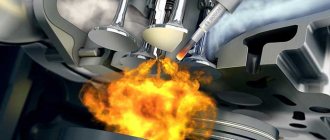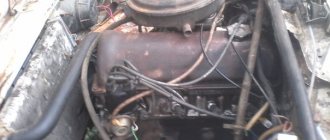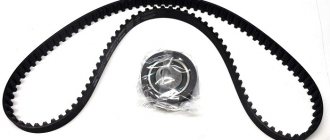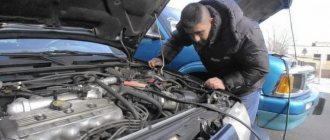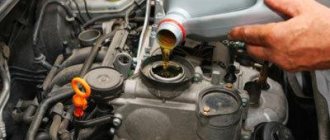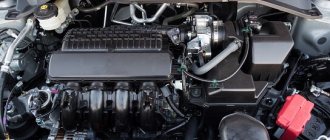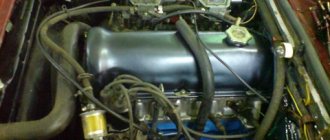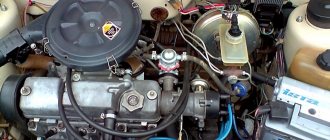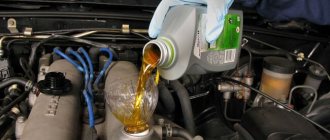If during an inspection you find oil in the air filter of a VAZ 2109, this may indicate serious problems. In order to eliminate this malfunction, you first need to know not only the mileage of the car, but also a number of other factors.
In order to identify and eliminate this malfunction, you need to have a clear understanding of the air filter and understand what it is intended for.
Why does oil get into the air filter?
There are 4 most common reasons why oil leaks into the air filter:
- Heavily worn and coked piston rings. Because of this, excess lubricant is poorly removed from the cylinder walls, and some of it ends up in the crankcase.
- The throttle hose for crankcase gases is clogged with dirt.
- Clogged oil deflector drain. The remaining liquid cannot flow through it back into the crankcase, and the oil mixed with gases floods the air filter.
- Critical contamination of the filter element, due to which it loses its quality and does not allow air mass to pass inside the engine in sufficient volume. To compensate for the lack of air, the engine begins to suck it from the crankcase.
The result is always the same - the air filter fills with oil. What to do if motor lubricant is found in the cleaner?
Mechanical drive for opening the throttle valve of the second chamber - Improved dynamics.
The Ozone 2107-…-10 carburetor is equipped with a pneumatic drive for opening the throttle valve of the secondary chamber; this device operates depending on the crankshaft speed. When a certain speed is reached, a vacuum is created in the carburetor channel leading to the pneumatic drive and the second chamber of the carburetor opens.
On the predecessor of the Ozone, the Weber carburetor, a mechanical drive of the second chamber was installed; in order to save fuel and emission toxicity, DAAZ engineers created a pneumatic drive. This is partly true, if not for the “dullness” of the car, known to many classic drivers, which appears due to the untimely opening of the secondary carburetor chamber.
This problem could be partially solved by removing the spring from the pneumatic drive (this method of improving dynamics was described in one of the issues of “Behind the Wheel”). However, this is not enough and craftsmen went further, converting the pneumatic drive to a mechanical drive for opening the throttle valve, as a result of which the secondary chamber opens earlier than with a pneumatic drive.
I also decided to conduct an experiment and install a mechanical drive for the second camera, especially since this alteration costs little money and if something happens, everything can be returned back. How to install a mechanical drive is quite difficult to explain with your fingers. You just need to carefully study how the mechanism of the throttle valve opening levers works. For additional materials, I needed an eyelet from a paper clip and that’s it. You need to unscrew one nut and install the eye.
It must be said that with a mechanical drive of the second camera, an improvement in the dynamics of the car is felt after 3000 rpm, for example, when overtaking. After 2500 - 3000 the revolutions are gained confidently.
Advantages of a mechanical drive of the second camera:
+ Increases vehicle dynamics at higher speeds.
+ The car slows down less at critical times.
Disadvantages of this design:
— Consumption increases from 0.5 liters per 100 km. If you press on the sneaker often and incorrectly, then the consumption increases quite noticeably. Read how I reduced gas mileage in this post: Increased gas mileage - Adjusting the level in the float chamber.
— You need to skillfully handle the accelerator pedal, the pneumatic drive now “does not think” for you and if you sharply press the gas at the beginning of the movement, a failure may appear.
Source
What to do if oil gets in
If oil flows into the air filter, this most often indicates a malfunction of the internal combustion engine. The deficiencies must be eliminated as quickly as possible before the engine fails. You can determine the reason why the air filter is in oil as follows:
- Check compression in all cylinders individually. 9-12 atm is considered normal. In this case, the compression values in different cylinders should be as close as possible - with a difference of no more than 1 atm. If the results obtained are below the minimum, this indicates serious problems with the engine;
- assess the color of the exhaust gases. If the exhaust is black or blue, the parts of the cylinder-piston group are worn out.
If the compression is normal and the smoke from the exhaust pipe is normal in color, the problem may not be with the engine. It is possible that oil is filling the air filter due to obstruction of the hoses for removing crankcase gases. In this case, it is enough to clean or replace the pipelines. If nothing has changed, you need to carefully check the internal combustion engine and related systems.
If you find that the engine air filter is oily, but you cannot postpone your trip, you can temporarily fix the problem and carry out a full repair after returning. To do this you need:
- remove the crankcase gas supply hose from the filter fitting;
- close the fitting;
- connect a longer hose to the crankcase ventilation so that the lower section of the tube is located below the level of the power unit.
This solution will allow you to use the car for some time without fear that the engine will suddenly fail. After completing the trip, you cannot postpone troubleshooting - major engine repairs will then be very expensive and take a lot of time.
Clutch wear indicator
How to determine when to change the clutch? It is difficult to say definitely when exactly this needs to be done. Mileage is also not an indicator. Everything is very individual and depends on operating conditions and driver habits. However, the following indicators can serve as a guide. Look at the image below.
If the length of the cable is adjusted in accordance with the manufacturer’s recommendations and the gap is 27 mm, but there is practically no free thread left on the threaded tip of the cable, this is a sure sign that the clutch is already “on its way.” You can start saving money and looking for a new set (basket, disc, release bearing). In some cases, it may be necessary to purchase an additional clutch fork.
You may know other reasons for a tight clutch pedal on your Lada Grant. It would be great if you share your experience in the comments to this article.
Solving the problem using the example of VAZ
Let's consider a specific case - oil was found in the air filter of a VAZ-2109. The malfunction is always corrected taking into account the characteristics of the machine. There is no fundamental difference here compared to other cars - first you need to check the compression level and look at the color of the smoke. The procedure for working with carburetor and injection engines is the same
What to do if you find traces of oil in a VAZ air filter, watch this video:
Any spare parts for Volzhsky Automobile Plant cars are not in short supply and are inexpensive. Therefore, if oil is flowing into the VAZ air filter, it is much cheaper and faster to carry out diagnostics and replace the purifier or pipelines than to overhaul the power unit later.
Causes of extraneous sounds in the gearbox
The gearbox is one of the elements of the transmission. Its name is derived from the English word reduce (reduce, reduce). The task of this unit is to transmit torque from the driveshaft to the wheels while simultaneously reducing speed.
The process is ensured by a gear system, bearings and differential. The drive gear is mounted on the driveshaft shank. The reduction in rotation speed occurs due to the difference in the number of teeth on the driven and drive gears that make up the main pair.
Tapping, humming and howling noises occur in the gearbox for several reasons. Let's name the four main ones in descending order of their prevalence:
· the gears of the main pair are worn out;
· the shank nut is not tightened correctly;
· the unit adjustment is broken.
Often car owners do not pay attention to the first signs of problems. As a result, the moment is missed when major repairs can be prevented with minimal intervention. For example, timely addition of specialized additives
to oils helps prevent wear of gears and delay the time for their replacement.
How to avoid the problem (prevention, prevention)
Here are the basic preventive rules that will help avoid a situation where the appearance of oil in the air filter is associated with a malfunction of the elements of the cylinder-piston group:
- Do not miss the deadline for replacing fuel and lubricants. If the manufacturer recommends changing the engine oil every 15,000 km, it is better to change it even earlier, after 10,000 - 12,000 km. This will help to avoid risks associated with the operating mode of the vehicle, seasonality, and the quality of the lubricant;
- Always change not only the oil cleaner, but also the air cleaner at the same time as lubrication;
- fill the fuel tank only with high-quality fuel from trusted manufacturers;
- Buy only certified engine lubricant.
By observing these simple requirements, you can not only improve the quality of the internal combustion engine, but also increase its service life. Additionally, a universal oil trap can be installed on the crankcase gas supply line. This part is inexpensive, but can provide guaranteed protection against lubricant getting into the filter element.
Mechanical opening of the second chamber of the OZONE carburetor
Hello everyone. From the name of the BZ it’s clear what we’re going to talk about. On the car, the OZONE 2105 carburetor, with a pneumatic drive for opening the second chamber, to be honest there are no complaints about it, worked as expected, but I wanted to accelerate when I really needed it and not when the pneumatic drive thought and opened the second chamber)) A lever and a 70 jet transition system were purchased second camera. (If anyone can’t find themselves in the city, please contact us)
I took a couple of days off and decided to devote some time to the car! Delov for 15-20 minutes)) I sharpened the lever a little (or rather a lot, I overdid it, but that’s not a big deal) so that the second chamber was completely closed, otherwise the engine idle speed increased slightly, by about 500 rpm.
On the engine side, I changed the transition system jet from 60 to 70
in order to avoid failure when the second chamber suddenly opens, in my case it was possible not to change it, I think, because the second chamber does not open completely, if you take its opening angle of 0-90 degrees, then for me it opens only 35 degrees, maybe 40, and then you have to press the gas pedal hard, it works at the lowest position of the pedal, the phrase pedal to the floor is very useful here)))
Source
conclusions
We figured out why the air filter may end up in oil and what needs to be done in this case. It is important to remember that if oil leaks into the air filter, in most cases the problem lies in the condition of the engine, and troubleshooting cannot be delayed. It is also recommended to inspect the air purifier more often - this procedure will take a few minutes, but you will be able to notice a malfunction in a timely manner and take the necessary measures.
Tell me what the problem is! I have a VAZ 2109 carburetor, why does it throw oil into the air filter?
Comments 23
unfortunately this is capital
it’s understandable to go outside, but sooner or later you’ll have to make capital money anyway, but you can get by with little blood
the pressure may also be escaping through the valve seats (guides), the exhaust pipe in oil is a sign of the Khan's rings (+ blue tint of smoke, specific smell) in order to continue driving and not spend money on repairs, our ancestors simply took the breather out to the street.
Oil may be leaking because the breather filter is clogged, the oil seals are worn out, or the rings are simply burnt out. If you say that there is no traction and high consumption, then the rings are burnt out, most likely you will have to overhaul the engine, but there is a small chance that it will cost you to replace the rings
Cardan shaft diagnostics
The process of diagnosing these elements occurs as follows. If it was not possible to identify the cause of the malfunction during a visual inspection (in case of serious breakdowns, the malfunction can be determined with the naked eye), then the element is disassembled and completely removed from the car. Its rotating components are placed on a balancing stand, while the static ones are cleaned of dirt and scrupulously inspected for mechanical damage. The suspension bearing is also checked for play. Only after the cause of the vibration has been accurately determined can we proceed to repairing the cardan.
Car air filter
Many people believe that the air filter is an ordinary unit and does not require special care. Especially if it has a modern, expensive air-purifying element. As a result, many motorists rarely check its condition and drive until it looks like an ordinary rag. Not everyone knows what happens as a result of such indifference. In this article we will touch upon the question of what the VAZ 2109 air filter element is and what exactly it is intended for.
Engine VAZ 2109
In order for the resulting combustible mixture in a VAZ 2109 engine with a carburetor or injector to burn completely, it is necessary that the air content in it be 15-20 times higher than the fuel content. As a rule, a car consumes about fifteen cubic meters of atmospheric air per hundred kilometers, which may contain particles of dust, grains of sand, plant seeds and other debris. Without a filter, these particles can end up inside the engine, regardless of what kind of injection system it has: injector or carburetor, and subsequently will have an abrasive effect on the rubbing parts, which will lead to premature wear.
The air barrier on the VAZ 2109 is designed to solve this problem. In addition to its main purpose, it, in turn, copes well with the function of a muffler and fuel cooler.
Carburetor settings Ozone 2105 and 2107 (changed 07/19/2018)
08/16/2015
Hello everyone!
This post will provide recommendations for setting up the Ozone 2105 and 2107 carburetor for normal operation. The overall success of carburetor tuning lies in the identified serviceability of the associated engine systems. These systems include spark plugs, ignition coil, distributor contacts or hall sensor and switch, phases and clearances in the gas distribution mechanism. The carburetor itself must be technically in good working order. If there is a blockage in the carburetor channels or another factor affecting its proper operation, then it is not recommended to proceed with adjustments. Our tuning example includes a completely washed and blown carburetor, but with incorrect settings of the jets, positions of the adjusting screws and float.
Adjusting the float
Remove the top carburetor cover and place it in a horizontal position with the float up. Measure the gap between the float and the carburetor gasket. The gap should be 4.5 mm. Place the carburetor cover in a horizontal position with the float down.
Measure the gap between the float and the carburetor gasket. The gap should be 12.5 mm. The float stroke should be 8 mm. The distance from the gasket to the bottom edge of the float should not be greater than the depth of the float chamber. The float must not touch the bottom of the float chamber. Adjustment of the float stroke is carried out by its two stops by bending them. Install the carburetor cap onto the carburetor. Connect the fuel hose and pump fuel into the float chamber using the fuel pump. Disconnect the fuel hose from the carburetor, remove the cap and check the fuel level in the float chamber. The fuel level should be in the middle of the inclined step in the float chamber.
Setting the initial position of the throttle valve 1 of the chamber
Screw in the throttle stop screw until the screw begins to touch the throttle stop lever.
After touching the screw, turn the screw 90 degrees clockwise. When tested against light, a thin ring of light should be visible. Setting the initial position of the throttle valve 2.
Screw in the throttle stop screw until the screw begins to touch the throttle stop lever.
After touching the screw, turn the screw 0.5 - 1 degree clockwise so that the screw supports the damper lever, but does not open it. The groove for the screwdriver on the screw must be aligned with the mark on the screw seat. When checking for light, the light ring should not be visible. Adjusting the fuel quantity screw
Remove the screw holder from the carburetor by unscrewing the two screws.
Set the exit of the threaded part from the screw body to about 0.8 mm. Install the screw holder onto the carburetor. When turning the screw clockwise, the amount of fuel decreases.
Adjusting the fuel quality screw
Turn the screw clockwise until it stops. Then unscrew the screw counterclockwise 2.5-3 full turns. When the screw is unscrewed, the mixture becomes richer
Adjusting the additional air supply screw
Tighten the screw until it stops. When the screw is unscrewed, the fuel supply speed is slowed down by air
Adjusting the EPHH valve
The EPHH valve must be screwed into the mounting hole until the EPHH nozzle touches the limiter.
This moment can be determined by lubricating the rubber ring with oil and observing the contact of the ring with the mounting hole. The valve must not be overtightened. An overtightened valve may become faulty. Adjusting the carburetor with the engine running
Start the engine.
Adjust the operating speed of the crankshaft using the quantity screw and increase it by 200-400 rpm. Set the position of the throttle valve of the first chamber with the stop screw, by turning the screw 90 degrees counterclockwise, so that the engine does not stall, but runs at a minimum number of revolutions. The groove for the screwdriver on the screw must be aligned with the mark on the screw seat. Adjust the number of revolutions with the quantity screw to 800-850 rpm. Setting the idle speed without instruments
- Use the quantity screw to set the idle speed to 850 rpm.
— Use the quality screw to set the maximum speed to XX. — Use the quantity screw to raise the speed by 100-120 rpm. — Use the quality screw to lower the speed to 850 rpm. By adjusting, you achieve smooth engine operation without shaking or popping in the muffler. Setting the idle speed using the IKS-1 device (instructions for the device)
Start the engine, set the mirror in a position convenient for observation, and use the quantity screw to set the minimum stable engine crankshaft speed. Using a mirror, observe the flame in the cylinder, the color of which depends on the composition of the working mixture. - Slowly turn out the mixture screw until a bright orange flame appears, indicating an overly rich mixture. — Slowly screw in the mixture quality screw until the orange flame disappears and a bright blue flame appears, indicating a normal mixture composition that ensures the best engine performance. — Turn the mixture quality screw another 1/2+1/4 turn and complete the adjustment. To avoid failure of the IKS-1 spark plug, it is forbidden to run the engine at high idle speeds (more than 1200 rpm).
After all the carburetor adjustments, the car should drive without dips or blockages throughout the entire crankshaft speed range, providing maximum power from a healthy engine.
To more accurately adjust the CO level, use the table
08/20/2015
Estimated quality of the mixture Formula for calculating coefficient a (from the table) a=Gв/(Gт*Iо), where Gв is the actual amount of air; GT - 1 kg of fuel; Iо - theoretical amount of air required for complete combustion of 1 kg of fuel - Theoretical gasoline - 1:15; — Aviation gasoline B-70 (solvent) — 1:14.7; — Gasoline AI-92 — 1:14. Types of mixtures 1:6.8 - upper limit of ignition of a flammable mixture;
1:0.8-1.5 - mixture for starting a cold engine; 1:9 - rich mixture (warming up); 1:12.6 - enriched, “power” (lowest fuel consumption at low loads and rpm, highest engine power); 1 kg of fuel: 15 kg of air - normal (the golden mean of rated power and efficiency); 1:16 - lean, “economical” (lowest fuel consumption at all loads except small ones); 1:17 - lean (less fuel, more air) - high fuel consumption, reduced engine power Calibration data for Ozone carburetors
09/10/2017
Adjusting the suction damper drive.
— The upper position of the rod promotes almost simultaneous movement of the dampers. At the same time, a rich mixture is maintained throughout the entire range of valve openings. The carburetor will not overflow even when the choke is fully “opened”, while the CV speed can reach up to 3000 rpm. Suitable for new and very worn engines
.
— The lower position of the rod moves the dampers alternately: first the upper damper until it is completely closed, and then the lower one until it opens slightly. With this scheme, when the upper damper is closed, the mixture will be over-rich, and when the choke is fully “opened”, the carburetor will overflow very much. On new engines,
the operation of the choke will have a better effect on warming up the engine in winter, i.e.
HF speed will not exceed 1500 rpm, which contributes to stable engine operation. On worn-out engines
, a catastrophic overflow will occur with disruption of the ignition system, especially in the summer.
07/19/2018
My settings of the OZON-2105 carburetor
All settings are in question, since replacing the UN spout gives a faster access to the maximum speed on the ground. — GTZH 1k — 135. — GVZH 1k — 170. — GTZH 2k — 150. — GVZH 2k — 150. — Spout UN — 5.0. — ZHKH 1k — 6.0. - quantity screw - length 2cm (2 turns). — quality screw — 1 turn (deflection of the screw in any direction reduces the speed). - extra screw air supply - tightened. - float gap - 4.5mm (fuel level above the step). — according to the ICS, fuel combustion is normal (blue flame). — OZ — 8-10 degrees. — spark plug gap — 1mm.
If the carburetor settings provide faster acceleration to 100 km/h, then after that the acceleration drops significantly, almost to zero. If the settings provide stable acceleration after 100 km/h, then acceleration from a standstill turns out to be slower. Apparently, as long as there is no strong air resistance, the fuel burns more efficiently, but with an increase in drag, the fuel burns very poorly, because the carburetor begins to overflow.
Source
Bearings are faulty
If the bearings in the transmission system are worn out, the gearbox hums and howls regardless of the driving mode. The sound is intrusive, reminiscent of a buzz, without crunching or knocking. They bear a significant load, since the bearings ensure rotation of the drive shaft of the gearbox. The failure of these rear axle parts is accelerated by an overtightened shank nut.
Untimely oil changes can cause accelerated bearing wear. Used oil loses its working properties, the lubrication of the rotating elements is insufficient, the rollers and bearing races overheat and quickly fail. The gearbox is humming.
What does it lead to?
: Severe wear of the bearings causes the formation of wear and grinding of teeth on the drive and driven gears. If repairs are delayed, the main pair may fail after the bearings.
How to fix
: Nothing can be done other than replacing the damaged part. Bearings must be renewed as soon as the characteristic noise of the gearbox appears.
Causes of malfunction
The VAZ 2107 rear axle gearbox is a complex and precise mechanism with a high degree of reliability. Nevertheless, for one car enthusiast it lasts the entire “life” of the car without the slightest problem, while another changes the gearboxes one after another, but the result is still the same. Based on practical observations, it is worth highlighting several reasons for the breakdown of the unit:
- operation of VAZ 2101-07 in extreme mode with overload;
- frequent slipping when moving from a stop;
- strong jerks when towing another car;
- loss of oil and dry driving;
- intervention of incompetent “masters”.
